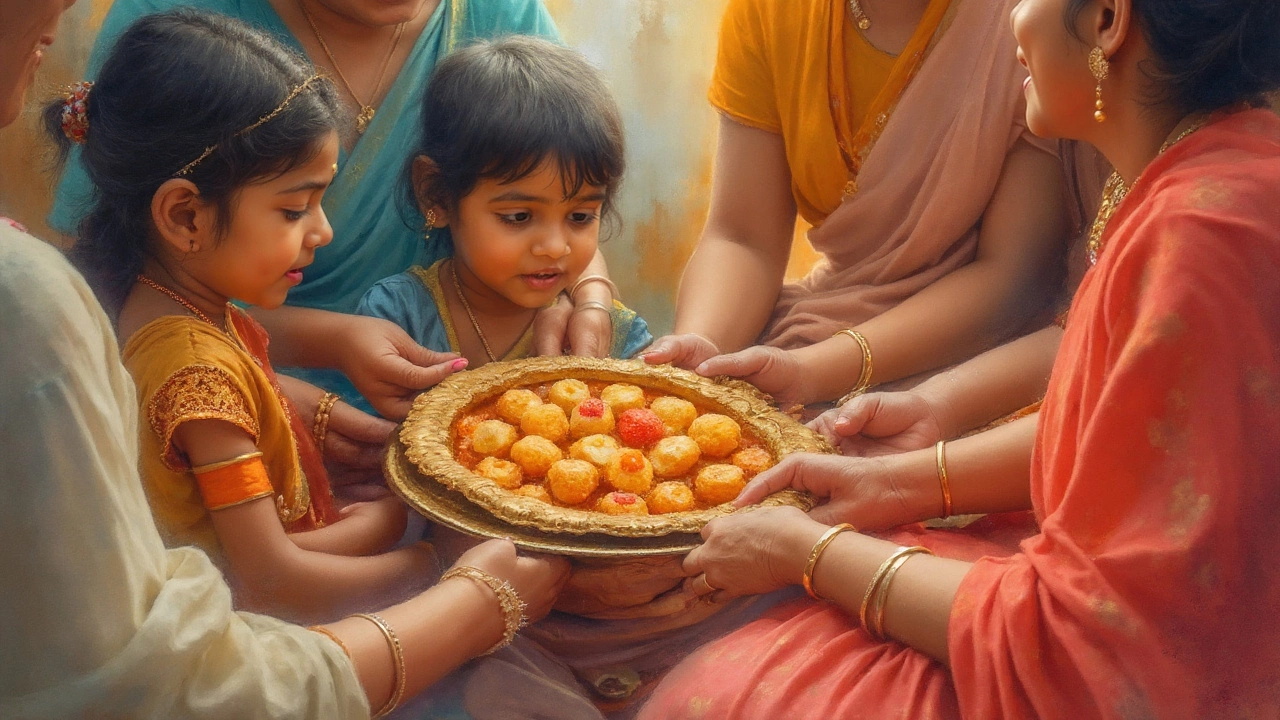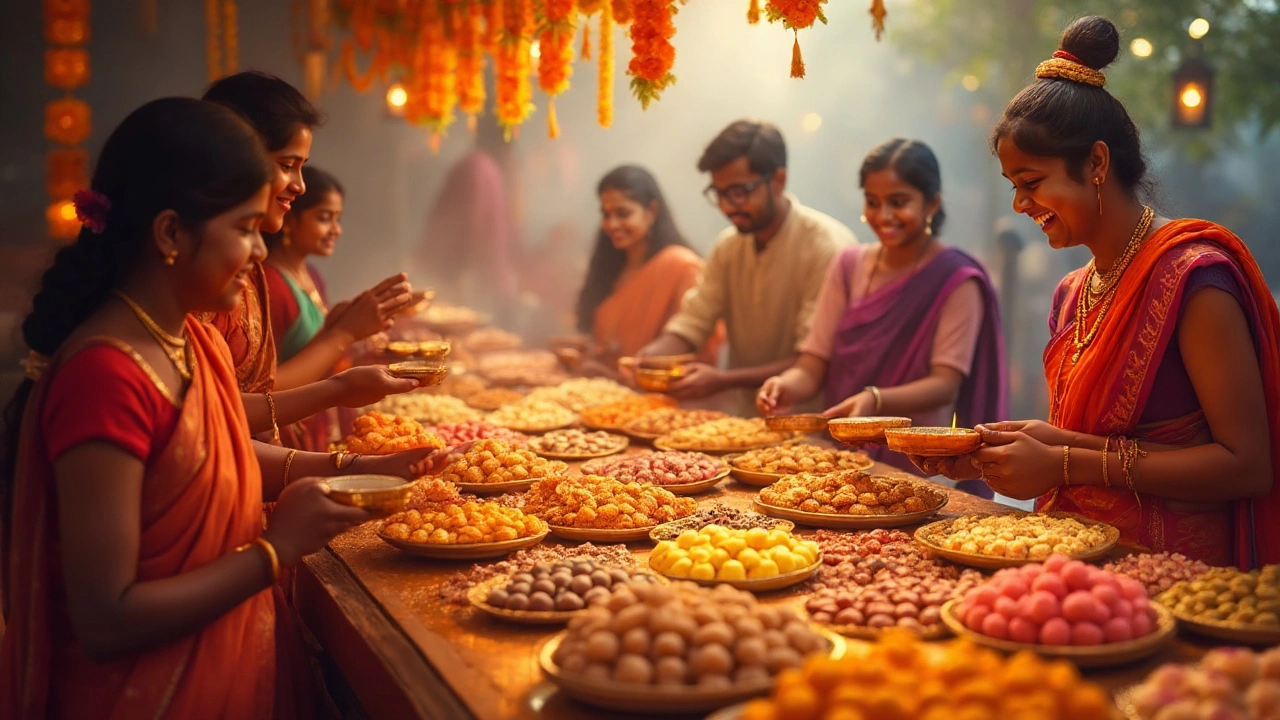It’s a muggy August night, and the sugar cravings are strong. You’re in India—let’s say crowded Delhi or a small town in Gujarat. Someone offers you a colorful piece of something glistening on a silver plate. What do you call it? Just 'sweet'? Not quite. There’s so much more to the Indian word for sweet than first meets the tongue. There’s language, there’s ritual, and there’s a story behind every morsel. The term isn’t just about flavor—it’s tangled up with culture, language, and the way Indians celebrate life. The moment you start peeling back the layers, you realize the word for sweet here is about a whole universe of experience.
What Do Indians Call Sweets? The Many Words and Their Meanings
Walk into any Indian home during a festival, and you’ll hear a familiar word: 'Mithai.' If you ask Indians, especially those who speak Hindi or most North Indian languages, what the word for sweet is, that's what you'll hear. Mithai isn’t just used in Hindi – it pops up in Bengali, Gujarati, Marathi, and even Urdu. But that’s not the whole story. Down South, the word 'Sweet' shows up, too. People say, 'sweets' in English for convenience, but if you listen closely, words like 'Madhu' (Sanskrit for honey or sweetness), 'Shirini' (in Persian-influenced cuisines), and even 'Payasam' (South Indian for sweet milk pudding) come up.
So what’s the deal? 'Mithai' comes from the Sanskrit word 'Madh' meaning sweet. You’ll find related words everywhere. In Bengal, ‘mishti’ is used (so 'mishti doi' for sweet yogurt). In Tamil, 'inippu' is used for the flavor of sweetness, but dishes themselves are often just called by specific names. Indian language is so layered that sometimes your grandma might use a mix: 'Give me some mithai, beta,' mixing English and Hindi without blinking.
Even the word itself is special: there isn’t a *single* Indian language with just one word for sweet. There’s the generic 'mithai' or 'sweet,' which covers the whole fuzzy, warm, sugar-dusted world of confections. But each specific sweet has a name and a story. Laddoo, jalebi, barfi, halwa, rasgulla—the list is endless. This is because sweets in India are much more than just desserts. They’re markers of community, festival, and a life event—like handing out laddu after a big exam result or serving peda at a wedding. The Indian vocabulary for 'sweet' is a testament to the country’s history of migration, language change, and local habits.
Don’t be surprised to find regional variations. What’s called 'mithai' in Lucknow is 'god' in Marathi-speaking Maharashtra, 'mishti' in Bangladesh, and 'shirin' or 'halwah' in Afghan-influenced areas. The practice is to use the regional word or the dish name. That’s how menus in restaurants hop back and forth, mixing local and traditional terms. It’s not just linguistics—it’s a celebration of diversity.
This is all about context. In daily life, you’ll hear 'mithai' for that box of sweets handed out during Diwali or Holi. You’ll see the word in shop names—like 'Haldiram’s Mithai' or 'XYZ Mishtanna Bhavan.’ And someone might just ask: 'Kuch meetha ho jaye?' meaning, ‘Should we have something sweet?’ That’s when you know sweets are not just a food, but an emotion, a little trigger for happiness.
Why Sweets Matter in Indian Culture
Ever noticed how Indians bring sweets into every possible celebration? The roots of that are deep—really deep. In Indian homes, sweets mark beginnings: births, marriages, new jobs, the first monsoon, exam victories, festival days, even moving house. It’s not overkill. It’s tradition. This emotional connection is visible in proverbs, song lyrics, and family rituals. If someone gets a new job, relatives will say, 'Mukh meetha karo' (Make your mouth sweet), passing around a plate heaped with laddoos, barfis, or something similar. There isn’t an Indian festival, Hindu, Muslim or anything else, without sweets taking center stage.
Sweets symbolize purity and luck. In some communities, the first bite of any celebratory meal is given to the gods—always something sweet. For example, in Hindu households, you’ll see offerings like 'modak' to Lord Ganesha, or 'payasam' to gods in South Indian temples. Even marriage proposals carried out in communities across India often begin with a tray of sweets, a sign that families are ready to share stories—and sugar.
Even the way sweets are given is about culture. Expect the host to serve you with their right hand, gently pushing the dish toward you. Refusing is mildly rude, but expected if you’re watching calories. But saying yes? That’s like getting a hug from an entire family. At Indian weddings, sweets flow—hundreds of kilos are prepared, packed in elaborate boxes, and distributed among neighbors, offices, and extended family. Some wedding planners say up to 30-40% of the guest’s food spend is on sweets alone!
Want to see the real importance of sweets? Take a look at the busiest time of the year for Indian confectioners: Diwali. This festival, celebrated all across India, is all about sharing happiness. Families stock up on boxes bursting with cashew-studded kaju katli, boondi laddoo, and pistachio barfi. Even in professional settings, bosses hand out sweet boxes to staff. People line up outside famous shops for hours to buy their favorite goodies. Historical accounts say that kings would often display their power by throwing huge feasts, with sweets piled high as pyramids. Sweets meant prosperity.
But it’s not all about tradition. In modern India, the sweet scene is evolving, too. Gourmet versions of age-old classics are in, as are fusion sweets. Think chocolate barfi and gulab jamun cheesecakes. Hip, urban crowds mix classical mithai with new flavors and ingredients from around the world. Yet, even as trends change, mithai is still central to the Indian way of life—old or young, north or south.
| Occasion | Common Sweets Served | Associated Meaning |
|---|---|---|
| Diwali | Laddoo, Kaju Katli, Barfi | Prosperity, Sharing, Joy |
| Wedding | Motichur Laddoo, Peda, Soan Papdi | Blessings, Good Luck, Togetherness |
| Birth | Rasgulla, Gulab Jamun | Celebration, New Beginnings |
| Religious Offering | Modak, Payasam, Halwa | Piety, Divine Favor |
| Exam Result | Peda, Laddoo | Achievement, Reward |

Delight in Diversity: Types of Sweets Across Regions
You might think of ‘sweets’ as a block. In India, it’s more like a mosaic. North Indian sweets have a lot of dairy—think soft rasgulla soaked in syrup or thick, fudge-like peda. Bengal swears by mishti doi (sweet yogurt) and sandesh (cottage cheese squares). Maharashtra brings you puran poli—a sweet flatbread. Down south? Then you’re not talking barfi, but payasam, a perfumed, milky pudding with rice or vermicelli. Let’s not forget Mysore Pak—made from ghee and sugar, melting at the first touch.
Here’s something wild: there are easily 500+ types of sweets across India. Every region puts its stamp on the flavor and ingredients. Take the state of Rajasthan: dry climate, so sweets like ghevar (a honeycombed disc) and mawa kachori (cheese-filled pastry) are favorites. Kerala is famous for ‘ada pradhaman’ (rice, coconut, and jaggery pudding). In Hyderabad, sweets are subtle, with hints of saffron, cardamom, and rose.
In Gujarat, you’ll find 'mohanthal,' a fudge with gram flour and ghee. Families put out a thali with different bites so that every guest can mix-and-match. Punjab, proud of its dairy, loves creamy phirni and milk cakes. Venture into Goa, and you get Bebinca—a layered, eggy dessert, shaped by Portuguese influence. In the Northeast, sweets dance between ‘pitha’—made of rice flour filled with coconut or prawn, and assorted rice puddings.
One thing ties all these together—sweets are usually vegetarian. But the flavors can be bold: spices are added (cardamom, saffron, clove), as are nuts (almonds, cashews, pistachios). Sweet dishes in India are not always grainy sugar bombs, though. Some are sweetened only with honey or jaggery (raw palm sugar). This is common in Ayurveda, which says that good sweets should balance out body heat and digestion.
Festival time? Kitchen tables get wild. Every family makes special sweets at home—modaks for Ganesh Chaturthi in Maharashtra, gujiya for Holi in North India, adhirasam in Tamil Nadu. The recipes are passed down for generations, and grandmothers claim their ranges are the best.
For folks new to this scene, here’s a quick and fun tip. Don’t try to sample everything in one go! Most traditional Indian sweets are rich—full of ghee, condensed milk, and sugar. Try a little—a single bite, with a cup of hot tea or just after a spicy curry. There’s a rhythm to it: first the salt, then the sweet. That's how Indian food works magic on your taste buds.
Understanding the Role of Sweets: Beyond the Plate
Beyond just eating, sweets have long been part of how Indians do business, strike friendships, and even heal. It’s common for shop owners to hand customers a bit of sweet after a big purchase, almost like sealing a contract. When families make up after an argument, they’ll share sweets as a way of forgiveness. Sweets also travel well—boxes of barfi or tin cans of soan papdi find their way across train journeys and long bus rides, connecting people with home.
Ever noticed why many Indian sweets have complicated shapes? It’s about art. Sweets are often decorated with edible silver leaf, called 'varak.' In Rajasthan and North India, you’ll see boxes lined up in sweet shops looking like tiny treasure chests—multicolored, sparkly, each with its own texture. The idea is, food is not just for the tongue; it’s for the eyes, soul, and even for memories. Those boxes, wrapped in colored paper or gold foil, often turn up at airports and weddings—proof that sweets, in India, travel as much as families do.
Nutrition-wise, Indian sweets get a bad rap for being sugary. But here’s the thing: most traditional recipes use ingredients considered healthy in moderation. Ghee, for example, isn’t just fat—it’s also part of Ayurveda. Jaggery contains minerals and is easier to digest than processed sugar. Chikki from Maharashtra is made of peanuts and jaggery, almost like an energy bar. Some families even prepare healthy variations, swapping sugar for dates or making laddoos with millets. That way, even those counting calories can join the party.
Don’t skip on the fun part—making sweets together is a family affair. Kids help shape laddoos or dip jalebi spirals in syrup. There’s singing, jokes, even a bit of flour-flinging. Every big holiday, kitchens get crowded and messy while families stir, fry, dip, and giggle over the stove. Even in cities, where kitchens are small, the tradition continues. People use WhatsApp to share recipes and swap pictures of their creations, celebrating tiny victories in the form of perfect gulab jamun or the first batch of soft peda.
There you have it: the word 'mithai' means much more than sweet. It’s a doorway to India’s language, rituals, hospitality, and joy. Next time you hear an Indian say ‘Have some mithai,’ remember—you’re getting a slice of culture, a nibble of history, and a taste of happiness. So why not try making or tasting an Indian sweet yourself? Whether it’s classic laddoo or trendy chocolate barfi, there’s a story inside every sugary bite.
